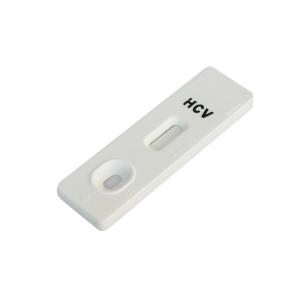

Add to Cart
HCV Rapid Test (whole blood)
HCV Rapid Test Device
Catalog No.: BG201C BG201S
Immunochromatographic test for the detection of HCV antibody in whole blood
INTRODUCTION
Hepatitis C Virus (HCV) is a small, enveloped, positive-sense,
single-stranded RNA virus. HCV is now known to be the major cause
of parenterally transmitted non-A, non-B hepatitis. Antibody to HCV
is found in over 80% of patients with well-documented non-A, non-B
hepatitis.
Conventional methods fail to isolate the virus in cell culture or
visualize it by electron microscope. Cloning the viral genome has
made it possible to develop serologic assays that use recombinant
antigens. Compared to the first generation HCV EIAs using single
recombinant antigen, multiple antigens using recombinant protein
and/or synthetic peptides have been added in new serologic tests to
avoid nonspecific cross-reactivity and to increase the sensitivity
of the HCV antibody tests.
HCV Rapid Test (whole blood) is a rapid test to qualitatively
detect the presence of antibody to HCV in whole blood specimen. HCV
Rapid Test is based on the principle of double antigen sandwich
immunoassay for determination of anti-HCV in serum. The recombinant
HCV proteins used in the test kit are encoded by the genes for both
structural (nucleocapsid) and non-structural proteins.
TEST PROCEDURE
1.Bring Membrane Plate and samples to room temperature (20-30°C)
before use (approximately 30 minutes).
2.Remove the test cassette/strip from the sealed foil pouch and
place the plate on flat desk.
3.Deliver 1 drops (50 μL) of the whole blood to the sample
well/sample pad.
4.then add 1 drops(50 μL) of Sample Diluent immediately
5.Read the result between 15-20 minutes. A strong positive sample
may show result earlier.
INTERPRETATION OF RESULTS
Negative: Only one colored band appears on the control region. No apparent band on the test region.
Positive: In addition to a pink colored control band, a distinct pink colored band will also appear in the test region.
Invalid: A total absence of color in both regions is an indication of procedure error and/or that test reagent deterioration has occurred.
